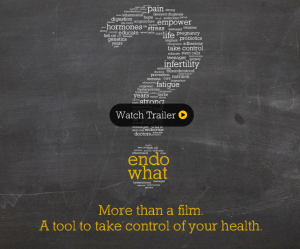Breaking the Cycle of Misinformation About Endometriosis
By Nancy Petersen, RN, and Heather Guidone
 Menstruation is a vital, normal process—yet remains linked to taboos, misconceptions and practices, particularly in relation to associated diseases like endometriosis. As a result, one of the most critical challenges facing the endometriosis community is a lack of factual awareness. The legacy of misinformation enshrouding the disease persists, propagated even by certain providers and organizations to patients, medical educators to next-generation professionals, health publishers to media, generation to generation. Consequences for these poor information systems are far-reaching, stifling the conversations we should be having about signs and symptoms of endometriosis that could lead to earlier intervention.
Menstruation is a vital, normal process—yet remains linked to taboos, misconceptions and practices, particularly in relation to associated diseases like endometriosis. As a result, one of the most critical challenges facing the endometriosis community is a lack of factual awareness. The legacy of misinformation enshrouding the disease persists, propagated even by certain providers and organizations to patients, medical educators to next-generation professionals, health publishers to media, generation to generation. Consequences for these poor information systems are far-reaching, stifling the conversations we should be having about signs and symptoms of endometriosis that could lead to earlier intervention.
Paul Altrocchi, MD once stated it would take “about thirty years for new ideas about endometriosis to take hold.” Yet for more than five decades, dedicated academicians and physicians have pointed out time and again that much of what we thought we knew about the disease is wrong. Still, misinformation remains ubiquitous, and the enduring lack of endometriosis awareness pervades every level of society—despite its status as a true public health crisis. So why do myths and obsolete ideas continue to drive care? Perhaps, as Spence Meighan, MD once said, “What we teach in medicine is over 50% wrong, but the problem is—we don’t know which half.”
Impacting an estimated 176 million individuals worldwide (WERF), endometriosis is characterized by the presence of endometrial-like tissue in extrauterine sites. The aberrant disease process gives rise to pain, inflammation, infertility/pregnancy loss, fibrosis/adhesions, organ dysfunction and much more. Influenced by myriad epigenetic, environmental and molecular factors, several mechanisms play roles in its pathogenesis. Though largely affecting reproductive-aged females, endometriosis can impact menstruators and non-menstruators alike. Even further isolated are rare cis males struggling to access care in a traditionally female-identified space, as well as LGBT patients who face additional challenges in settings that fail to be inclusive. Prevention and non-surgical diagnosis remain elusive, and many sufferers are frustrated by widespread lack of understanding. Most patients will need complex, multidisciplinary care, e.g. excisional surgery combined with adaptation of lifestyle changes, yet few are guided towards Laparoscopic Excision (LAPEX) and remain unaware of important adjuncts such as physical therapy, nutritional approaches and alternatives that may help when combined with quality surgery. Even those who are directed towards effective resources may still find themselves faced with insurmountable barriers.
Whilst minor cramping with periods may be expected, bloating, pallor, rebound tenderness, nausea/vomiting, painful cramping and bowel movements, painful bladder, pain with exercise, interruption of sleep, pain with sex and so much more are simply not routine accompaniments to a normal menstrual cycle. By contrast, early disease intervention can reduce morbidity, infertility and progressive symptomatology in patients of all ages. Yet in order for those affected to make educated choices about health pathways, they must be provided with correct information upon which to base decisions. Likewise, although endometriosis research seems omnipresent, much of it is redundant in nature and sorely lacking in translational benefit. Moreover, much of the effort is directed towards pharmaceutical diagnosis and management, which do not provide long-term solutions.
“Blame the patient” remains common, and individuals are still too often told the pain is either normal or in their heads; others espouse ancient notions of Sampson’s Theory of Retrograde Menstruation as cause, and hysterectomy, drug therapy, incomplete surgery or pregnancy as cures. Press coverage around endometriosis is often connected to high profile subjects and typically rife with inaccuracies, which in turn get shared in perpetuity. For example, a recent article covering a celebrity’s reported ‘time off’ because of her endometriosis depicted the disease as a “hard to diagnose” illness only affecting older women, characterized by normal endometrium merely implanted elsewhere by means of “backwards periods,” easily treated by drugs, hysterectomy or non-excisional surgery. This is the kind of awareness endometriosis does not need.
This lack of authoritative awareness contributes to decade-long delays in diagnosis and effective care. Consequences of the perpetuation of generational taboos/secrecy, poor health literacy and a prevailing ethos of menstrual shaming—by physicians, caregivers, peers and media alike—are associated with acceptance of “The Curse” mentality. Cultural attitudes towards the menstrual cycle as a hygienic crisis or embarrassing burden have profoundly negative effects. In today’s progressive society, ignorance of facts can lead to deficient health practices and adverse medical, educational and social outcomes:
- Menstrual shaming and invalidation of painful symptoms leads to increased absenteeism, synonymous with lost educational and fiscal opportunities;
- Low confidence levels and suboptimal therapy choices among clinicians;
- Familial and social isolation;
- Negative construct across media and peer groups;
- Lack of social and physical support mechanisms; and
- Physical worsening of disease leading to negative self-objectification, body shame or sexual decision-making; permanent damage including loss of fertility; deficient quality of life and even, as we have tragically observed recently, loss of life.
We must put an end to the divisiveness and lack of collaboration among stakeholders, who should be working together towards solutions; we must continue to lobby policymakers for robust institutional changes to further benefit those struggling with the illness; we must end the secrecy, isolation and pain of countless sufferers; we must revitalize and create a space for menstrual communication, broaden the gender dialogue and engage in key conversations. We must allow the endometriosis community’s voice to be heard. We believe we can alleviate the culture of menstrual misinformation through behavior changes, encouraging research, expanding fundamental components of management, increasing authoritative awareness, and reducing costs through improvement and standardization of care for those in need.
Many individuals first experience symptoms of endometriosis at or even before menarche, and while often chronic in nature, may endure elevated pain levels associated with periods. Whereas Vital Signs are used to measure body’s basic functions and assess general physical health, give clues to possible disease and show progress toward recovery, framing the menstrual cycle as an additional Vital Sign would allow clinicians to use menstrual cycle patterns and symptoms to potentially improve disease recognition and intervention. Positive change can also be achieved through a widespread, targeted public health campaign which incorporates the media, healthcare personnel, school curriculum and parents, so cultural norms can be challenged and allow individuals to be informed—and vocal—about an otherwise normal biological occurrence when things go wrong.
We must embark on robust changes in the status quo, with upstream targeting that begins in the school setting and is shared across multidisciplinary providers. Developing educational programs reflecting the true nature of this disease can help patients and clinicians identify sooner. This is all possible, but medicine has to care; must consider they may have been going in the wrong direction for a century. Endometriosis is not a fatal disease, but despair can be. Indeed, it is not just gynecology sharing the blame; primary care, the media and public also need to stop telling individuals painful periods, dyspareunia, infertility, bowel and bladder problems and more of the same are normal occurrences or a “part of life” that is easily treated.
Those with endometriosis are not broken people at fault—this is a systemically broken system which has failed them. This disease is a social justice, medical, financial–even human rights issue. We plead for an urgent shift in priorities if we are to realize improved time to diagnosis and increased access to efficient treatment. We must break the cycle of misinformation to bridge the gap. The global endometriosis community deserves nothing less.
Nancy Petersen–fondly known as “Nurse Nancy”–began her career over fifty years ago at Good Samaritan Hospital & Medical Center in Oregon, in the Neurosurgical Division. She later founded the country’s first endometriosis surgical treatment program focused on evidence-based, high-quality, minimally invasive excision at St. Charles Medical Center. Nancy hosts a Facebook Endometriosis Education and Discussion Group.
Heather Guidone is the Center for Endometriosis Care’s Program Director, specializing in ‘bench to beltway to bedside’ efforts encompassing endometriosis and education, clinical research facilitation, health policy reform, training, health literacy, adherence and patient-centered caregiving.
Both women have spent their lives fighting for education, advocacy and awareness, with directed focus on the psychosocial aspects of the disease and societal attitudes towards menstruation and pelvic pain. Both lived–and struggled–with endometriosis for decades. Material presented herein is for information purposes only and should not be construed as medical advice or directive. The Center for Endometriosis Care is neither affiliated with nor endorses any products/devices or support/resource organizations.
Center for Endometriosis Care: Information for current and prospective patients, For news, general information and articles
Premiering March 16, 2016: Endo What – a feature documentary that is more just a film. 


Thanks for giving us an opportunity to share our thoughts and experience